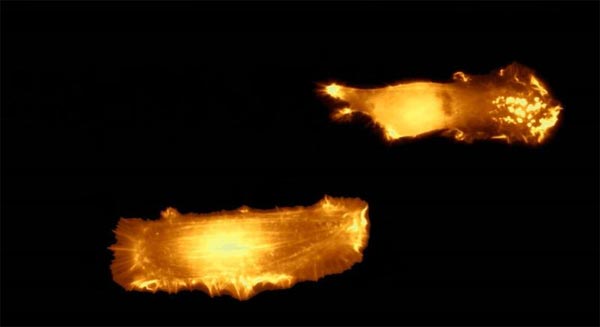Basel Scientists Are Bringing Cells on the Fast Track

The stimulated upper cell migrates targeted in only one direction, while the not stimulated cell changes its direction periodically and migrates approximately five times slower. University of Basel, Department of Biomedicine
Cells migrate by connecting their cytoskeleton – a network made up of proteins – to adhesion molecules which in turn get in contact with the surrounding connective tissue. In order to guide cells in a certain direction a signal from outside is needed, which leads then to cell polarization and coordinated mechanical movement. A fundamental question is how signaling pathways are regulated in time and space to facilitate directional migration of cells.
Classical cell migration experiments use uniformly coated glass plates with the drawback that cells adhere very strongly to the glass surface and move randomly in any direction. This random cell movement aggravates comprehensive studies of directional cell migration.
Mimicking organisms
In their study, scientists around Prof. Olivier Pertz from the Department of Biomedicine at the University of Basel gained novel insights into the regulation of directional cell migration: Using a special procedure, 20 micrometer wide lines were fabricated on glass thereby mimicking the connective tissue environment – creating a highway for cells. In addition, cells were stimulated with a growth factor (PDGF) which led to fast cell migration in only one direction lasting for many hours.
“This shows that we can achieve robust and directional cell migration by mimicking the geometry of connective tissue as we find it in the body,” tells Olivier Pertz. Certain dot-like structures, that are always located at the front of the cell, adopt a crucial role in maintaining long term polarized cell migration.
The research results give novel insights into how signaling pathways are regulated in time and space in order to facilitate migration of cells only in one direction. The scientists describe novel concepts of cell migration, which could help to find new targets and approaches to fight cancer metastasis and inflammation. “The more insights we get into the mechanisms of cell migration, the more effectively and focused we will be able to intervene in certain pathological processes,” first author Dr. Katrin Martin comments.
Original source
Katrin Martin, Marco Vilela, Noo Li Jeon, Gaudenz Danuser, Olivier Pertz
A Growth Factor-Induced, Spatially Organizing Cytoskeletal Module Enables Rapid and Persistent Fibroblast Migration
Developmental Cell, Volume 30, Issue 6, 29 September 2014, Pages 701–716 | doi: 10.1016/j.devcel.2014.07.022
Further Information
Prof. Olivier Pertz, University of Basel, Department of Biomedicine, phone: +41 61 267 35 41, email: olivier.pertz@unibas.ch
http://www.cell.com/developmental-cell/abstract/S1534-5807%2814%2900488-2 – Abstract
Media Contact
All latest news from the category: Life Sciences and Chemistry
Articles and reports from the Life Sciences and chemistry area deal with applied and basic research into modern biology, chemistry and human medicine.
Valuable information can be found on a range of life sciences fields including bacteriology, biochemistry, bionics, bioinformatics, biophysics, biotechnology, genetics, geobotany, human biology, marine biology, microbiology, molecular biology, cellular biology, zoology, bioinorganic chemistry, microchemistry and environmental chemistry.
Newest articles

Webb captures top of iconic horsehead nebula in unprecedented detail
NASA’s James Webb Space Telescope has captured the sharpest infrared images to date of a zoomed-in portion of one of the most distinctive objects in our skies, the Horsehead Nebula….

Cost-effective, high-capacity, and cyclable lithium-ion battery cathodes
Charge-recharge cycling of lithium-superrich iron oxide, a cost-effective and high-capacity cathode for new-generation lithium-ion batteries, can be greatly improved by doping with readily available mineral elements. The energy capacity and…

Novel genetic plant regeneration approach
…without the application of phytohormones. Researchers develop a novel plant regeneration approach by modulating the expression of genes that control plant cell differentiation. For ages now, plants have been the…





















